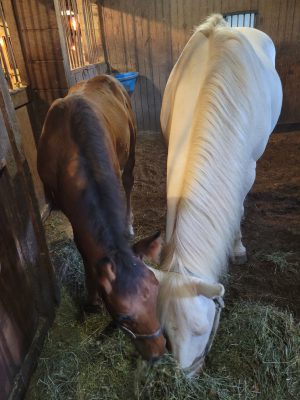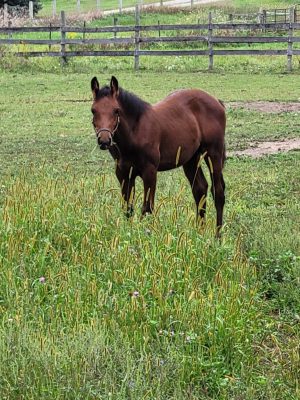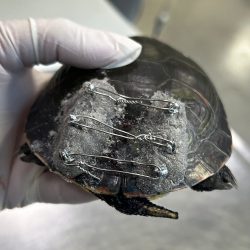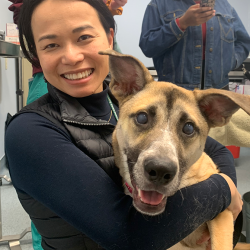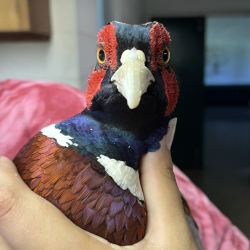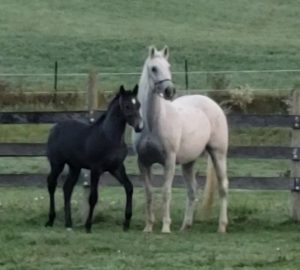
Equine dystocia, or difficulty birthing a foal, is not uncommon, but always urgent. After Rouby, an 18-year-old Oldenburg mare, was in labor for more than three hours, and two weeks late on delivery, her owner Valerie knew quick action was needed to save her beloved mare and her unborn foal.
“From the time that the chorioallantois—the outer membrane of the equine placenta—ruptures, the delivery of the foal should take less than 30 minutes,” says Dr. Ashley VanderBroek, clinician for the MSU Large Animal Clinic. “In fact, prompt intervention is warranted if no progression is made after only 10 minutes of Stage II labor. Delayed delivery increases the likelihood of fetal asphyxia—lack of oxygen and blood flow to the fetus’ brain—and other neonatal problems associated with hypoxia—lack of oxygen—due to placental separation. Studies have shown that for every 10-minute increase in the duration of Stage II labor beyond 30 minutes, there is a 16 percent increase in the foal not surviving to hospital discharge.” So, time was of the essence for Rouby and her foal.
When horse owners and veterinary professionals are faced with dystocia, there are four intervention options: assisted vaginal delivery, controlled vaginal delivery, cesarean section, and fetotomy. Prior to her arrival at MSU, Rouby’s primary care veterinarian attempted assisted vaginal delivery. In this procedure, the mare is standing, and a caretaker attempts to assist the mare in delivering the foal. “This technique typically is successful for simple mutations, like flexed extremities,” says VanderBroek.” Unfortunately, neither the primary care veterinarian nor their associate was able to make any progress. So, Valerie readily brought Rouby to MSU.”
On presentation at MSU, Rouby was bright, alert, and responsive. Vital parameters (temperature, heart rate, and respiratory rate) revealed a fast heart rate and abnormally rapid breathing, likely secondary to discomfort. Rouby was in distress, but she was hanging on. The next step was to perform an abdominal ultrasound to check on her foal; there was no evidence of a fetal heartbeat, nor was the foal responding to stimuli, and the foal was in a very precarious position within Rouby’s womb, explaining the trouble with delivery. Rouby also displayed symptoms of hemorrhage as well as mild dehydration.
“Since there wasn’t a detectable fetal heartbeat, a controlled vaginal delivery under general anesthesia was recommended and elected,” says Vanderbroek. Controlled vaginal delivery is performed with the mare under general anesthesia and in Trendelenburg position, with the hind limbs suspended. This allows for deeper repulsion and can be successful for more difficult mutations, such as the one that Rouby’s foal was in.
“I was hoping and praying they would save Rouby,” says Valerie.
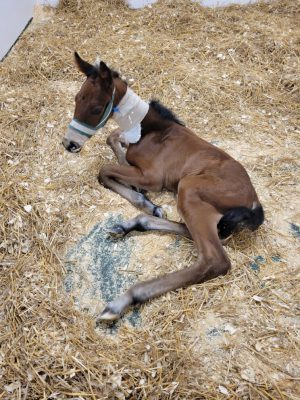
After more than five hours of labor, Rouby delivered a beautiful, living colt. The colt was part Oldenburg (mare) and part Irish Draft horse (sire). “Because Rouby had been in labor for more than five hours by the time that the foal was delivered, we were utterly shocked that the foal was alive, and even more impressed by how well he did post-delivery. Despite having all the odds against him, this colt was one of the healthiest foals we’ve seen this year,” says VanderBroek.
“I have to admit, I was in shocked when they called me,” recalls Valerie. “I remember saying, ‘Oh my gosh, save him! Save him!’ I couldn’t believe that after such a long, difficult labor, they were both alive.”
A more than five-hour-long labor took a toll on Rouby, and despite having birthed a strong, healthy colt, she wasn’t doing well. So, Valerie and the veterinary medical team turned their focus on her recovery. “Everyone at MSU was very honest and informative. We thought, all we can do is try to save them both. They gave me a lot of peace and lot of hope,” says Valerie.
To help Rouby bond with her foal, a small amount of her amnion was placed on the colt’s back; she immediately accepted him and allowed him to nurse.
Though their bond was strong, and despite supportive care, Rouby’s condition was deteriorating. Overnight, her heart rate continued to rise, and she became dehydrated even with being on consistent fluids. Diagnostic tests showed that Rouby was suffering from septic peritonitis, an inflammatory and often fatal condition. Due to her acute and severe clinical decline and a grave prognosis, a humane euthanasia was elected.
“Rouby was my favorite mare of all time. She was the absolute sweetest girl,” remembers Valerie. “I’m just so thankful that the foal got to nurse from her before she passed. That way, she knew what she had done.”
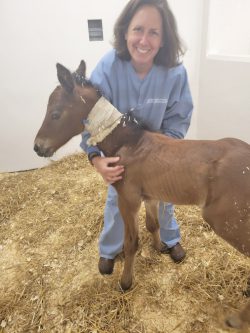
Despite having all the odds against him, this colt was one of the healthiest foals we’ve seen this year!
The foal, given the name Lazarus, remained well and healthy. As MSU’s equine team monitored him closely, Valerie began to search for a nurse mare. “When I knew I would need a nurse mare, I got on social media. There are several sites to go to for help,” says Valerie. “People are so gracious to help.”
For foals whose mares are lost during birth, or due to other unfortunate circumstances, the need for a nurse mare is multipurposed. “Foals who don’t have moms and are taken care of by people, plus are bottle-fed or doing bucket-feeding exclusively, tend to lack horse sense,” says Valerie. “They can get aggressive and pushy. A mare teaches them how to behave around humans, to pay attention to their surroundings, and the difference between right and wrong.” This is on top of the nutritional benefits of mare’s milk as well as the mutually beneficial bond between a mare and a foal.
In a matter of hours, a potential nurse mare was found: a Friesian named Aske, owned by Dirk and Kathy TenHaaf. Though Aske and Lazarus didn’t take to one another, Valerie was touched by the generosity. “I was so impressed by how many people offered me mares, not knowing anything about me or where the mare was going after MSU,” she says. While Valerie continued began the search for another potential nurse mare, Lazarus remained strong, eating and drinking more each day.

The next day, another potential nurse mare, Pearl—who is owned by Dinah Strunk and Heidi Knight from Hartford, MI, and lives at the barn Pearlfection—was placed in the stall next to Lazarus. The window between stalls was left open for a slow introduction and the following day the pair were united under supervision. The introduction went well, and Pearl allowed him to nurse. No stranger to being a “mom,” Pearl had fostered a one-month-old two years prior and birthed her last foal in 2014.
The bond between Pearl and Lazarus strengthened over the following days. He was no longer on antimicrobial treatment, and the supplemental milk offered in a bucket was reduced as Lazarus was nursing from Pearl. At the time of Hospital discharge, the young colt was healthy and active with normal foal behavior—much in part due to Pearl and her gracious owners.
“I think a lot of people have been surprised when I tell them people were willing to give me their mares with no idea who I was! Very caring people!” says Valerie, who had people across the country offering mares as ’moms’ for Lazarus. “People are so gracious to help. I had six mares offered to me. A woman in the state of Washington got in touch with Pearl's owner and told her there was a foal in Michigan who needed a ‘mom.’ That gal then got in touch with me! How fortunate.”
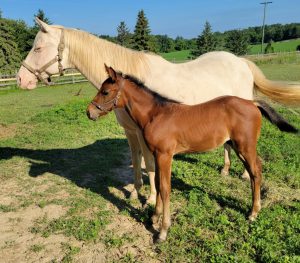
More than two months following the foal’s birth, Lazarus and Pearl are reported to be doing well at the barn where they currently live together. “It's interesting to watch Pearl correct Lazarus when he sucks too hard or bites when he nurses or jumps on her trying to get her to play—or he's just aggravating her. Nature has a way of directing instincts in the right direction,” says Valerie. Pearl, a very welcome guest, will remain with them for another few months, or until shortly after Lazarus is weaned at 4–6 months old.
In the meantime, Lazarus is growing stronger every day, under the watchful eye of his “mom” Pearl. “Lazarus will walk into a connecting paddock, leaving Pearl behind, and doesn't get excited at all. He's a very smart 3-month-old!” cheers Valerie. “He is one of the smartest foals I've had, which is incredible when you know how traumatic the birthing was! Those Irish horses are tough.”
Lazarus spent eight days at MSU. During that time, he and Valerie became family to their medical team. “He’s my favorite foal ever!” says Libby, veterinary nurse for the Large Animal Clinic.
“Surprises like these are always welcome!” cheers VanderBroek .
